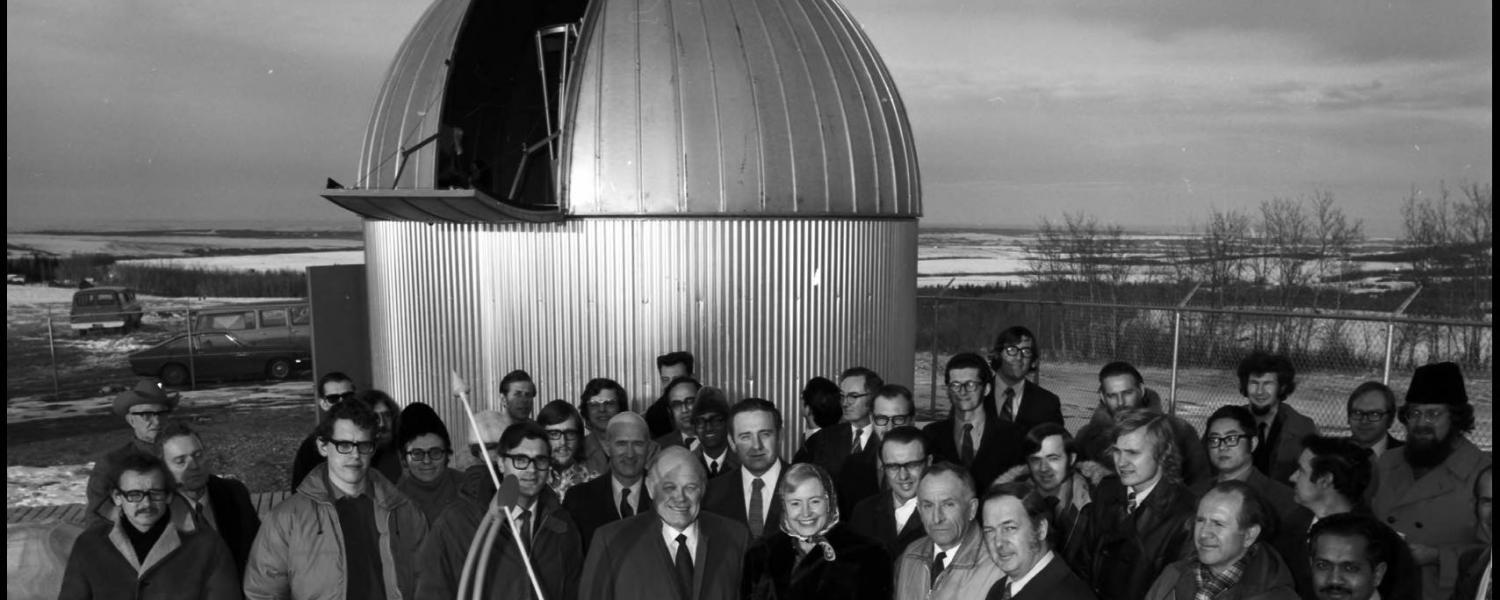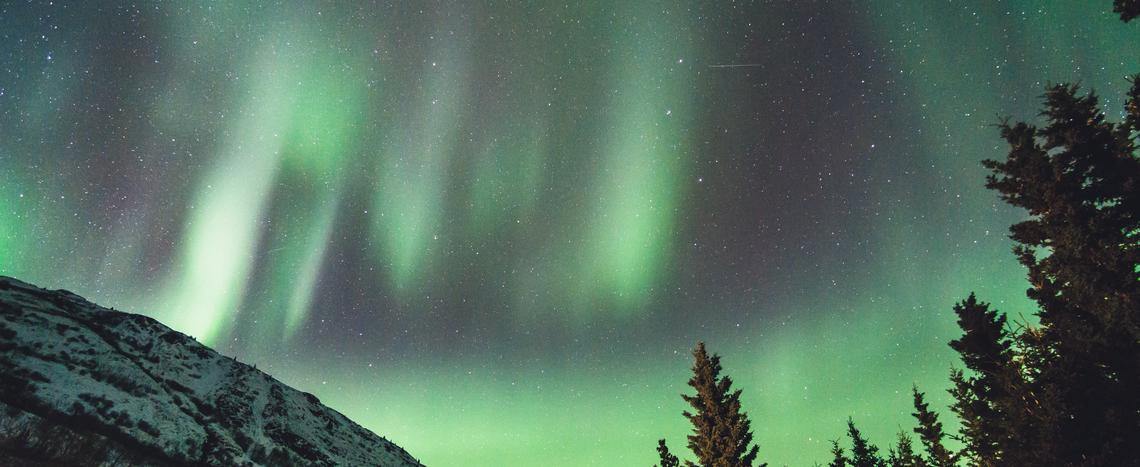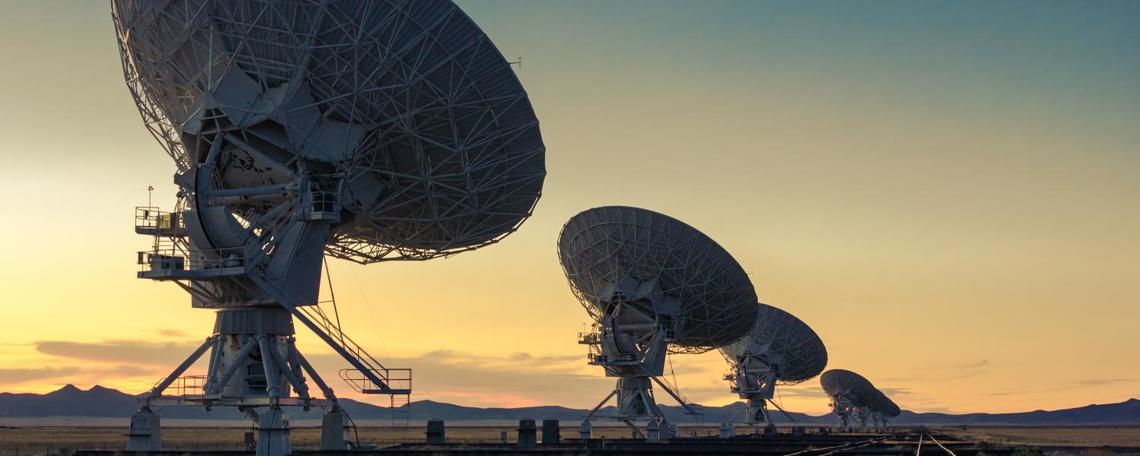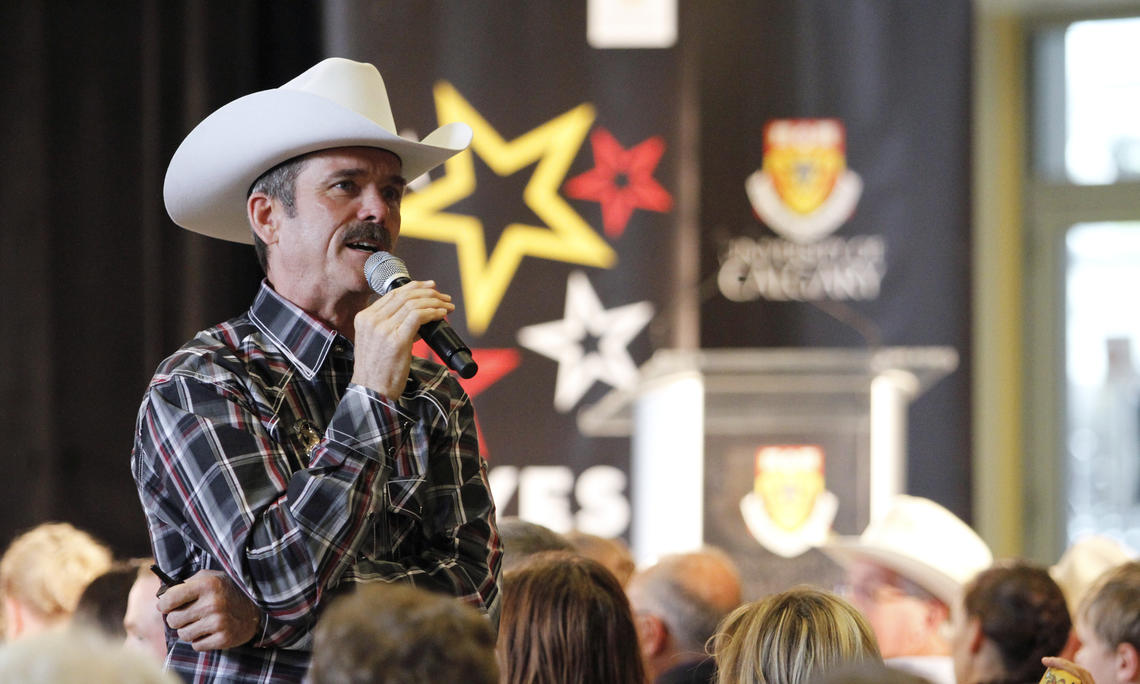
Our place in the universe
Seeking Answers to the Big Questions
Finding answers to questions about our origins, using those answers to further understand this big, beautiful planet, its past, present and future; that's the business we are in. Tracking the data, sharing that knowledge, and helping others to also explore our place in the universe is what makes any academic pursuit worthwhile.
Exploring our Origins
Feathered dinosaurs, meteorite discoveries, cosmic rays, the atmosphere and other phenomena. Partnering with other institutes, universities and governments help make the journey of discovery possible.

1956
SULPHUR MOUNTAIN COSMIC RAY RESEARCH STATION ESTABLISHED
The first meteorological station on Sulphur Mountain was built in 1902 and consisted of a twelve-foot square stone hut. For the next 30 years, Mr. Norman Sanson climbed the peak every week or fortnight to replace the recorder charts; in winter the journey could take up to 9 hours on snowshoes.
The Cosmic Ray Station was built in the winter of 1956-57 as part of Canada’s contribution to the International Geophysical Year (1957-58). Cosmic rays intensify at the geomagnetic pole and are easier to track at higher elevations; the monitor on Sulphur Mountain was among the most sensitive in the world.
The Cosmic Ray Station became operable in late spring 1957 after the hauling and installation of five tons of equipment at the site. Dr. Brian Wilson of the National Research Council was appointed Office-in-Charge; his initial research trip was extended by a week at the station after he came down with the chicken pox.
The Station was part of a world-wide network of cosmic ray monitors; the data received and recorded was invaluable in the furthering of our understanding of space. Research at Sulphur Mountain included measuring cosmic ray intensity variations and interactions, properties of extensive air showers, solar flares and the study of auroral emissions. In an era before long-term space probes were viable, the study of cosmic rays was our window to interplanetary space.
The Cosmic Ray Station was closed and the building was dismantled in 1981. The university initiated proceedings to officially recognize the Station’s valuable contributions to international science; a National Historic Site plaque was placed on Sulphur Mountain in 1984.
1957
SPUTNIK I LAUNCHED
The Space Race begins and an emphasis on science education.
1962
RESEARCH ROCKET LAUNCHED
Dr. Baxter, Dr. Will, Dennis Green, Charles Hansen and William Jones of the Physics Department, complete a successful probe in the third series of X-ray research rocket fringes from Resolute Bay, NWT. Their Black Bryant III rocket is sent 100 miles (160 km) into the upper atmosphere.
1968
UNPRECEDENTED ARCHAELOGICAL FIND
Bison butchering site with 7,000-year-old bones and tools is dug up by construction workers. Archaeology Department faculty and students describe it as the first good archaeological find in Calgary.
1969
APOLLO 11 MOON LANDING
Dr. Gordon W. Hodgson, Exobiologist (study of extraterrestrial life) awaits samples of the moon gathered on Apollo 15 mission. Hodgson becomes a principal investigator of Apollo moon samples.

1971
AURORAL IMAGES CAPTURED
UCalgary helps capture the first global auroral images from space.
1972
ASTROPHYSICAL OBSERVATORY OPENS
Originally called the University of Calgary Astrophysical Observatory, the facility is later renamed the Rothney Astrophysical Observatory after Alexander Rothney (Sandy) Cross, who donated the land for the observatory. His father was A.E. Cross, one of the Big Four ranchers who backed the 1912 Calgary Stampede
1978
SPACE SCIENCE RESEARCH GROUP ESTABLISHED
Later named the Institute for Space Imaging Science in the '90s.
1981
COSMIC RAY STATION CLOSES AS RESEARCH BECOMES OBSOLETE
The National Research Council established a Cosmic Ray Laboratory on Sulphur Mountain—one of three in Canada. The research into cosmic rays has matured and become obsolete and the Sulphur Mountain lab was closed, however the data gathered over the 32 years in operation is invaluable to this day.
1987
PINPOINT PRECISION
Cairn erected by Surveying Engineering to commemorate the 1987 Canadian Engineering Centennial. It is the most precisely measured place in Canada at LSD 14 30-24-1 W5, 115.4 m above sea level, 6,366,344 metres from the centre of the earth, 384,400 kilometres from the moon and 149,600,000 kilometres from the sun.
1989
HUB OF EXPLORATION
Institute for Space Research established. UCalgary named headquarters of Canadian Network for Space Research.
1992
RESEARCH ABOARD SPACE SHUTTLE COLUMBIA MISSION
NASA space shuttle Columbia blasts off carrying a UCalgary science experiment to determine how much energy astronauts use when they are in space. Mechanical engineering grad, Laura Lucier, and 2004 Distinguished Alumni award recipient, worked at NASA’s Johnson Space Centre as flight controller during the Discovery mission.
1996
CHANCELLOR ROBERT THIRSK IN SPACE
His first trip into space was aboard Columbia on which Thirsk and six crewmates performed 43 experiments related to life and materials sciences.
1999
MARTIAN PROBE SENT INTO SPACE
The design of an atmospheric probe, called a Thermo-Plasma Analyzer (TPA), led by physics and astronomy professors Greg Garbe and Andrew Yau, was successfully launched on the Japanese spacecraft Planet-B. The probe remained in orbit for three years to survey Mars.

2000
ARABIAN DESERT SURRENDERS QUEEN OF SHEBA'S SECRETS
3,000-year-old temple opens a new door to Arabia's ancient civilizations
Researchers from the University of Calgary are participating in an American Foundation for the Study of Man project to unlock the secrets of a 3,000-year-old temple in Yemen. Archaeologists believe the temple could prove as significant a discovery as the ruins of Pompeii, the pyramids of Giza, or the Acropolis of Athens.
The Mahram Bilqis - pronounced Mah-ram Bill-kees (or Temple of the Moon God) lies buried under the sands of the southern Arabian Desert in northern Yemen and is believed to have been used throughout the reign of the legendary Queen of Sheba. According to University of Calgary archaeology professor Dr. Bill Glanzman, the project's field director, the sanctuary was a sacred site for pilgrims throughout Arabia from about 1200 B.C. to 550 A.D.
Eight limestone pillars remain standing at the front of the temple, half-buried by the desert sands. Behind the site's peristyle hall, a wall of heavy limestone blocks (around 3.5 metres thick), covered in ancient inscriptions, surround the sanctuary. While the top six metres of the wall are exposed, sub-surface surveys of the area indicate the temple's foundations still lie 9–10 metres below the sands. Glanzman estimates it will take another 2–3 years before the excavation of the walls is completed.
Despite the team using state-of-the-art equipment, the excavation and documentation of the site remains a slow process, with the work frequently being hampered by sand storms and blistering heat.
While excavating, researchers have discovered large quantities of animal bones at the site, suggesting the sanctuary was used for animal sacrifices. Samples of these bones have been brought back to the UCalgary for DNA analysis and for comparison with the skeletons of modern species.
Once the site has been excavated, Glanzman says the team plans to restore and reconstruct sections of the temple to show visitors how they believe it looked during its last period of use in the 6th Century.
"The ancient builders of this temple used extremely advanced engineering techniques," says Glanzman. "To reconstruct it, we first have to understand how the original stone masons carved the blocks and then teach the Yemeni masons these skills. We're hoping to rejuvenate crafts and masonry skills that have lain dormant for more than 1,400 years."
Plans have been discussed to retain part of the sanctuary as it was found, giving archaeologists of the future—who will have different methods and more advanced technology—opportunity to work on the site in its original condition.
"In many respects, the Queen of Sheba's kingdom was the cradle of the Arab civilization and the Mahram Bilqis was at the very heart of this kingdom," he says. "This temple may well be considered the eighth wonder of the world."
2001
PREHISTORIC PEDESTRIANS
Archaeologist Brian Kooyman, geologist and paleontologist Len Hills and their research team discover 13,000-year-old tracks of wooly mammoths, camels, horses, bison and caribou in St. Mary’s Reservoir in southern Alberta.
2009
GOING TO GREAT HEIGHTS TO HONOUR ASTRONAUT
Canadian Space Agency astronaut and UCalgary alumnus Robert Thirsk has become the first Canadian to receive an Honorary Doctor of Laws via live downlink from the International Space Station.
GPS TECHNOLOGY HELPS CANADIAN ALPINE SKI TEAM
A little GPS system called STEALTH, developed at the Schulich School of Engineering, has helped the country’s best ski racers perfect their technique and route down a course.
2010
NOW SHOWING: CANADA'S NORTHERN LIGHTS
AuroraMAX online observatory begins streaming Canada’s northern lights live over the Internet every night. AuroraMAX is a collaboration between the Canadian Space Agency, UCalgary, City of Yellowknife and Astronomy North.

2012
WORLD'S BIGGEST RADIO TELESCOPE
Physics professor Russ Taylor appointed to represent Canada in project that will create the world’s biggest radio telescope
Physics professor Russ Taylor is set to play a leading role in a mega-science project that will create the world’s biggest radio telescope, the Square Kilometre Array. Taylor has been appointed to represent Canada on the international SKA Board, the decision-making body for the project, alongside a National Research Council of Canada representative.
"Becoming a member of the international SKA organization means that Canadian researchers and industries can participate in the planning and design of the Square Kilometre Array, and in its eventual construction,” says Taylor, physics professor in the Faculty of Science, chair of the Canadian SKA consortium board and director of the Institute for Space Imaging Science.
As a partner, Canada along with Australia, China, Italy, the United Kingdom, the Netherlands, New Zealand and South Africa will determine the location of the SKA—either Southern Africa or Australia-New Zealand.
"The international partners in SKA are extremely pleased that Canada has now formally joined the project. Our Canadian colleagues bring a history of technical and scientific strengths to the partnership and we very much look forward to working with them to make SKA a reality,” says John Womersley, chair of the International SKA Organization Board.
The university and NRC have for several years been involved in research and development for the SKA. Researchers from the Schulich School of Engineering are working on the design for the receivers that will pick up signals from deep space. Radio astronomers and computer scientists in science faculty are developing information systems for a global network to manage the vast amount of data what will be produced.
Instead of gathering and focusing visible light like optical telescopes, radio telescopes operate in the radio-frequency portion of the electromagnetic spectrum and typically use large, dish-shaped antennas, “seeing” a universe that is invisible to our eyes.
The SKA will be made of thousands of receptors linked together across an area the size of a continent. The total collecting area will be about one square kilometre. The first astronomical observations are expected toward the end of this decade.
The university, through the Institute for Space Imaging Science, will hold a workshop April 27 to develop international linkages and the national collaborations among Canadian industry, government and university research for Canadian participation in the pre-construction phase of the SKA.

Chris Hadfield, a retired Canadian astronaut who served as the commander of the International Space Station, makes his first public presentation of his images and stories of space at the University of Calgary on July 6, 2013
2013
COL. CHRIS HADFIELD VISITS CAMPUS
UCalgary hosts astronaut Hadfield for his first public presentation since leaving the International Space Station. Hadfield shared his breath-taking photos and remarkable accounts of his time in space.
2014
FUNDING RECEIVED TO STUDY SPACE STORMS
Christopher Cully, Faculty of Science, will lead a team from UCalgary, University of Washington and Dartmouth College to develop a novel in-flight experiment that will clarify the dynamics of the harsh radiation environment satellites travel through and why the high-energy particles that make up that radiation rain collide with the upper atmosphere.
2015
SPACE FLIGHT BONE LOSS STUDY
Radiologist Dr. Steven Boyd, will lead one of four experiments conducted by Canadian universities. His project, dubbed “TBone" to reflect the ‘three-dimensional bone’ techniques used, will investigate the effects of weightlessness on the human body.
